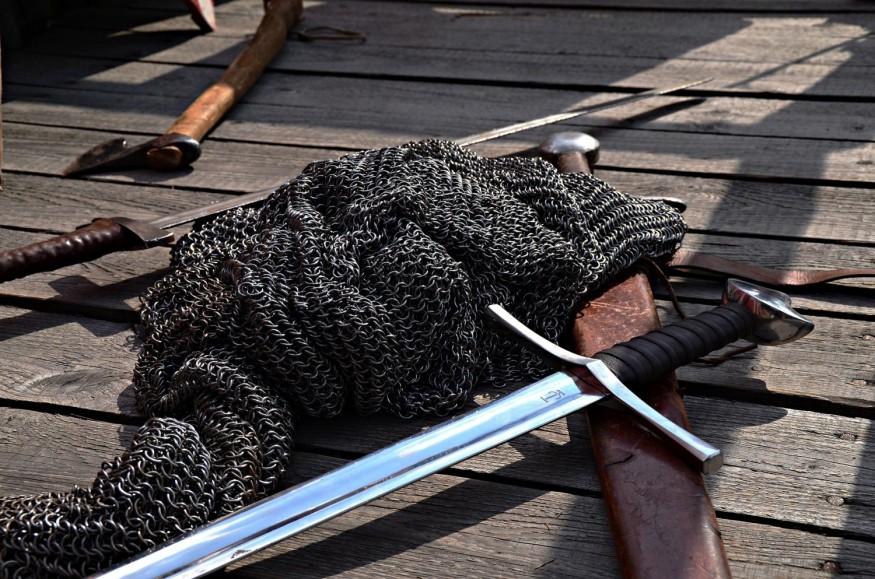
Of the many weapons and tools humans have created throughout history, none are as popular or enshrined in myth as the sword. Designed with the sole purpose of killing, swords have revolutionized human technology and warfare. Furthermore, their history and legends have also captured people's awe, imagination, and curiosity for centuries.
Legendary swords such as King Arthur's Excalibur and Charlemagne's Joyeuse stand out in history. However, the real life blades that have existed and survived across millennia tell stories just as fascinating - and scientists are only beginning to unveil them. In this decade alone, archeologists have uncovered stunning swords that enlighten human civilization's past. These are some of the most impressive archeological finds of the past few years.
900-year-old Crusader Sword Off Israel's Coast
In late 2021, scuba diver Shlomi Katzin accidentally stumbled upon a medieval treasure trove: a 900-year-old sword on the sea bed, revealed by the shifting sand. Katzin found the weapon alongside other relics that date back to the Crusades which lasted from 1095 to 1291. Also known as the Holy Wars, the Crusades were medieval wars where European Knights sought to "take back" the holy land in what remains one of the bloodiest conflicts in history.
The crusader sword, which measures nearly 4 feet (1.3 meters) long, still had a recognizable shape of a sword when Katzin retrieved it and took it to the Israel Antiquities Authority (IAA). Despite being encrusted in marine life, the medieval sword was perfectly preserved. The IAA stated that it is thought to be made of iron and once belonged to a crusader Knight.
Sword And Mirror Shield Unearthed From Burial Mound In Japan
The beginning of 2023 brought about the stunning discovery of a 7.5-foot (2.3 meters) long sword in Nara, Japan. Found last November during excavations of the Tomio Maruyama burial mound, it was accompanied by a mirror that was shaped like a shield. The sword and shield are believed to have been ritualistic weapons meant to protect the dead from evil spirits in the afterlife.
According to archeologist Riku Murase, the sword was forged in an undulating pattern characteristic of dakō blades, but is twice as big as any other sword found in Japan. Its size, shape, and ritualistic purpose shows the outstanding craftsmanship of Japanese sword making skills that went beyond what was understood by scientists.
Rare Byzantine Ring Pommeled Swords in Turkey
Two unusually crafted swords were found in the medieval stronghold of Amorium in Turkey. Both made of iron, the sword's handles integrate aspects uncommon in the Byzantine Empire: a ring-shaped pommel combined with an inscribed cross guard at the end of the handle. The two weapons were found eight years apart, but have been dated to the same period, between the 10th and 11th centuries.
The first sword was found half corroded underneath a church in Amorium in 1993 and the second at the lower part of the city in 2001. A study published in 2021 in the Journal of Art History detailed how unusual the swords were: not only were the ring pommels uncommon in the Byzantine Empire, but these weapons were also different from ring pommeled swords found in other parts of the world. In fact, both these swords were so unique the scientists have trouble defining their origin and purpose.
Mushroom Hunter Discovers Bronze Age Sword In Czech Republic
While foraging for mushrooms on a spring day in 2020, Roman Novák from the Czech Republic found more than he expected. In the rural hills of Jesenicko, the man saw something that caught his attention. Digging a little deeper, he unearthed a 3,300 years old bronze sword and an accompanying bronze ax.
The sword is a beautiful example of an ornate Bronze Age weapon, with a pommel and hilt decorated in intricately engraved circles and crescent-shaped patterns in black and gold. Damaged but in a complete state, the sword is now at the Silesian Museum, the oldest museum in the Czech Republic.
X-Ray scans prove that the sword has a bronze blade, with air bubbles characteristic of technology from the Bronze Age when swords were made by pouring molten bronze into a mold. Following its discovery in an area formerly considered as "archaeologically marginal", the Silesian Museum moved its teams to the site to try to find other hidden artifacts.
Pieces Of Unique Viking Sword Reunited After 1,200 Years
In 2022, two metal detectorists in Stavanger, Norway, discovered odd pieces of metal that turned out to be three separate pieces of an intricately carved and decorated Viking sword. Though the blade is still missing, the components of the hilt and pommel of the sword still fit together perfectly, making up what archeologists have called a Peterson Type D-sword, one of the larger and heavier swords from the Viking Age.
Featuring ornate gold and silver carvings, the hilt is sculpted like an animal head and has patterns made using the niello technique. This decoration could indicate the sword was made in the Frankish Empire. The researchers at the University of Stavanger believe the complex design and the rarity of this type of weapon indicates that it could have belonged to someone wealthy as the sword pieces were located near the "Gausel Queen", one of the wealthiest Viking graves ever found in the country.
© 2026 ScienceTimes.com All rights reserved. Do not reproduce without permission. The window to the world of Science Times.











